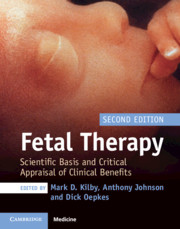Book contents
- Fetal Therapy
- Fetal Therapy
- Copyright page
- Dedication
- Contents
- Contributors
- Foreword
- Section 1: General Principles
- Section 2: Fetal Disease: Pathogenesis and Treatment
- Red Cell Alloimmunization
- Structural Heart Disease in the Fetus
- Fetal Dysrhythmias
- Manipulation of Fetal Amniotic Fluid Volume
- Fetal Infections
- Fetal Growth and Well-being
- Preterm Birth of the Singleton and Multiple Pregnancy
- Complications of Monochorionic Multiple Pregnancy: Twin-to-Twin Transfusion Syndrome
- Chapter 31 Twin-to-Twin Transfusion Syndrome: Placental and Fetal Pathogenesis
- Chapter 32 Twin-to-Twin Transfusion Syndrome: Treatment by Fetoscopic Laser Coagulation of the Placental Vascular Anastomoses on the Chorionic Plate
- Chapter 33 Interventions for Early and Late Twin-Twin Transfusion Syndrome
- Chapter 34 Diagnosis and Treatment in Twin Anemia Polycythemia Sequence
- Chapter 35 Neurological and Long-Term Neurodevelopmental Outcome after Fetal Therapy in Complicated Monochorionic Twins
- Complications of Monochorionic Multiple Pregnancy: Fetal Growth Restriction in Monochorionic Twins
- Complications of Monochorionic Multiple Pregnancy: Twin Reversed Arterial Perfusion Sequence
- Complications of Monochorionic Multiple Pregnancy: Multifetal Reduction in Multiple Pregnancy
- Fetal Urinary Tract Obstruction
- Pleural Effusion and Pulmonary Pathology
- Surgical Correction of Neural Tube Anomalies
- Fetal Tumors
- Congenital Diaphragmatic Hernia
- Fetal Stem Cell Transplantation
- Gene Therapy
- Section III: The Future
- Index
- References
Chapter 31 - Twin-to-Twin Transfusion Syndrome: Placental and Fetal Pathogenesis
from Complications of Monochorionic Multiple Pregnancy: Twin-to-Twin Transfusion Syndrome
Published online by Cambridge University Press: 21 October 2019
- Fetal Therapy
- Fetal Therapy
- Copyright page
- Dedication
- Contents
- Contributors
- Foreword
- Section 1: General Principles
- Section 2: Fetal Disease: Pathogenesis and Treatment
- Red Cell Alloimmunization
- Structural Heart Disease in the Fetus
- Fetal Dysrhythmias
- Manipulation of Fetal Amniotic Fluid Volume
- Fetal Infections
- Fetal Growth and Well-being
- Preterm Birth of the Singleton and Multiple Pregnancy
- Complications of Monochorionic Multiple Pregnancy: Twin-to-Twin Transfusion Syndrome
- Chapter 31 Twin-to-Twin Transfusion Syndrome: Placental and Fetal Pathogenesis
- Chapter 32 Twin-to-Twin Transfusion Syndrome: Treatment by Fetoscopic Laser Coagulation of the Placental Vascular Anastomoses on the Chorionic Plate
- Chapter 33 Interventions for Early and Late Twin-Twin Transfusion Syndrome
- Chapter 34 Diagnosis and Treatment in Twin Anemia Polycythemia Sequence
- Chapter 35 Neurological and Long-Term Neurodevelopmental Outcome after Fetal Therapy in Complicated Monochorionic Twins
- Complications of Monochorionic Multiple Pregnancy: Fetal Growth Restriction in Monochorionic Twins
- Complications of Monochorionic Multiple Pregnancy: Twin Reversed Arterial Perfusion Sequence
- Complications of Monochorionic Multiple Pregnancy: Multifetal Reduction in Multiple Pregnancy
- Fetal Urinary Tract Obstruction
- Pleural Effusion and Pulmonary Pathology
- Surgical Correction of Neural Tube Anomalies
- Fetal Tumors
- Congenital Diaphragmatic Hernia
- Fetal Stem Cell Transplantation
- Gene Therapy
- Section III: The Future
- Index
- References
Summary
Twin-to-twin transfusion syndrome (TTTS) is a complication unique to monochorionic (MC) twins and affects 10–15% of MC twins, including MC twin pairs in higher order multiple pregnancies. The disease has fascinated obstetric specialists since it was first described in 1875 [1], when it was recognized as a condition not amenable to treatment and with a very high perinatal loss rate. Since then, TTTS has provided many challenges, not only in terms of deciphering the underlying pathogenesis but also in attempting to alter the clinical course of a condition with a >90% perinatal loss rate untreated and very high (>50%) neurological morbidity in any surviving babies [2, 3]. Outcomes improve dramatically with treatment, which will be discussed in detail in Chapters 32, 33, and 35. However, even with treatment 12% of TTTS pregnancies will end with a double fetal loss, and only 62% with two survivors [4].
- Type
- Chapter
- Information
- Fetal TherapyScientific Basis and Critical Appraisal of Clinical Benefits, pp. 344 - 352Publisher: Cambridge University PressPrint publication year: 2020

